- If the potential for a soil to retain SO4 (Table 1) is low or medium and no manure has been applied in the past two years, a S application will most likely be needed for crops with a high relative need for S such as alfalfa. Sulfur application guidelines for alfalfa are provided in Table 2.
- If the soil is organic or if a significant amount of manure was recently applied, a profitable yield response to applied fertilizer S is unlikely.
- For most other soil and cropping conditions, verify the need for S using tissue testing while considering the relative S need of the crop to be grown.

Is tissue testing a viable option for alfalfa?
The ideal diagnostic approach is to take a tissue sample of the top six inches, or top one-half of the alfalfa plants if they are less than eight inches tall. Samples of 35 plants should be collected when the alfalfa plants are between six inches of growth and early bloom. More detailed information on tissue sampling can be found at https://uwlab.triforce.cals.wisc.edu/wp-content/uploads/sites/17/2016/02/pa_sampling_sfal.pdf
The advantage of a tissue sample, and an accompanying soil sample, is that this technique measures that impact of all sources of plant-available S by measuring what is actually getting taken up by the plant.
A plant tissue survey of alfalfa field conducted in 2010- 2011 (Laboski, 2012) showed that 62% of the fields sampled were low in sulfur (<0.25%). This is a large increase from a survey conducted about ten years earlier (Kelling, et. al. 2002) which showed that just over one-third of all samples indicated that alfalfa S levels were <0.25%.
What form should be used and how often should sulfur be applied?
All SO4 forms of fertilizer are equally effective when surface-applied or incorporated. Elemental S, however, is insoluble and must be transformed into sulfate-sulfur by soil bacteria before plants can use it. The rate of this transformation depends on particle size, degree of mixing with the soil, and soil temperature. To be effective, elemental S should be worked into the soil well in advance of the time the crop needs it. Without mechanical incorporation, elemental S is incorporated to some extent by falling into cracks when the soil dries or by the activity of earthworms and burrowing insects.
Crops such as alfalfa and corn silage can remove large amounts of S in one season. If alfalfa will be grown on soils needing S, either elemental S or SO4 forms such as potassium sulfate, ammonium sulfate, potassium-magnesium sulfate, or calcium sulfate (gypsum) can be used. If the soil is known to be deficient in S, include some sulfate-sulfur in topdress applications for immediate S availability. When applied at recommended rates, sulfate-sulfur will generally last for two or more years, while elemental S should last for the term of the stand. Sandy soils may require annual applications of SO4 forms of S because the SO4 leaches through these soils more rapidly than loamy soils. Irrigation water, however, may contain sufficient sulfate-sulfur for the crop. In these cases, response to fertilizer S is likely only in years with above-average rainfall, when little irrigation water is applied. Additional information on sulfur is available in UW-Extension publication Understanding Plant Nutrients: Soil and Applied Sulfur (A2525).
Source:uwex.edu